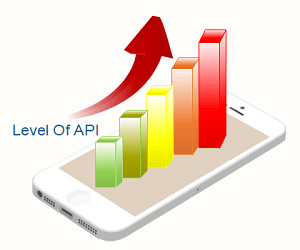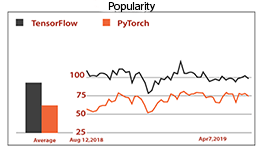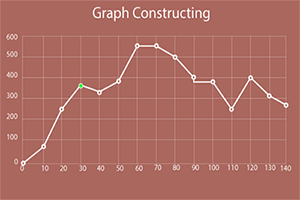PyTorch vs. TensorFlowIt is required to understand the difference between the PyTorch and TensorFlow for starting a new project. Libraries play a crucial role when developers decide to work in deep learning or machine learning researches. According to a survey, there are 1,616 ML developers and data scientists who are using PyTorch and 3.4 ML developers who are using TensorFlow. We will compare both the frameworks based on the following factors: 1) Origin
PyTorch is a machine learning library which is based on Torch library. Facebook's artificial intelligence research group developed it for application, such as deep learning and natural language processing. It is free and open-source software which is released under the Modified BSD license. Tensor flow is also an open-source machine learning, which was initially developed by Google. 2) Features
PyTorch has several attracting features such as:
These features ensure less time for running the code and increase in performance. On the other hand, TensorFlow has also distinguished and attracting features such as TensorBoard which will be a great option while visualizing a machine learning model. It also provides TensorFlow Serving, which is a specific grpc server which is used during the deployment during the production. 3) Community
PyTorch has much lesser community than TensorFlow. TensorFlow is adopted by many researchers of various fields such as business organization, academics, etc. In TensorFlow, it is easier to find for resources or solution. There is a great number of tutorials, codes, as well as support in TensorFlow and PyTorch. 4) Level of API
If we will talk about the API, then the TensorFlow is the best one because it provides both high and low-level APIs. PyTorch provides lower-level API which focuses on the direct work with array expression. PyTorch has gained great interest in the last year and becoming a preferred solution for academic research and application of deep learning, which requires optimizing custom expression. 5) Speed
PyTorch and TensorFlow are two most popular deep learning framework. PyTorch is suitable if we are working in our home, and we are implementing our first deep learning project. But TensorFlow is used if we are working in our office, and we have an excellent knowledge of deep learning projects. If we compare both PyTorch and TensorFlow with their speed, then both the framework provides a similar pace, which is fast and suitable for performance. 6) Popularity
Based on popularity, TensorFlow is widely used rather than PyTorch. Every organization needs simple and readable architecture with the high performance of large dataset execution. PyTorch is younger than TensorFlow and has grown rapidly in popularity. PyTorch allows customization, whereas TensorFlow does not. TensorFlow has the most GitHub activity, Google searches, Medium articles, books on Amazon, and ArXiv articles. It is used by most of the developers and is listed in the most online job descriptions. 7) Ramp-Up Time
PyTorch is a GPU enabled drop-in-replacement for NumPy which equipped higher-level functionality for building and training the deep neural network. If we are familiar with Python, NumPy, and deep learning abstraction, it makes PyTorch easy to learn. When we write TensorFlow code, it will first get "compile" into a graph by Python and then run by the TensorFlow execution engine. TensorFlow has a few extra concepts to learn, such as the graph, the session, placeholder, and variable scoping. The ramp-up time of TensorFlow is definitely longer than PyTorch. 8) Coverage
TensorFlow natively supports certain operations such as flipping a tensor along a dimension, checking a tensor for Nan and infinity and Fast Fourier transforms. It also has the contrib package which is used for the creation of more model. It provides support for the use of the higher-level functionality and gives us a wide spectrum of options to work with. PyTorch still has fewer features implemented, but due to all the attention, it will be bridged real soon. PyTorch is not popular as TensorFlow among learners and freelancers. 9) Deployment
Both the frameworks are easy to wrap in for small-scale server-side deployments. TensorFlow works well for mobile and embedded deployments. A non-trivial amount of work is required in TensorFlow for deploying it to Android and IOS. We don't have to re-write the entire inference portion of our model in C++ or Java. PyTorch cannot be hot-swapped easily without bringing the service down, but TensorFlow can do that easily. 10) Serialization
Loading and saving models are very simple with both the framework. PyTorch has a simple API which can pickle the entire class if we want or save all the weights of a model. In serialization, the main feature of TensorFlow is that the entire graph can be saved as a protocol buffer and includes parameters and operation as well. After that, the graph will be loaded in other supported language such as Java and C++. TensorFlow is critical for deployment stacks where Python is not an option. TensorFlow can be useful when you change the model source code, but it should be able to run old models. 11) Graph Constructing and Debugging
PyTorch has a dynamic nature of the entire process of creating a graph. The graphs can be constructed by interpretation of the line of code which corresponds to that particular aspect of the graph so that it is entirely built on run time. With TensorFlow, the graph construction is static and need to go through compilation. After that, it will run on the execution engine which we have mentioned previously. 12) Visualization
Visualization plays an important role while we present any project in an organization. For visualizing machine learning models, TensorFlow has TensorBoard, which helps during training the model and spot the errors quickly. It is a real-time representation of the model's graphs that does not only show the graphic representation but also shows the accuracy graphs in real-time. This feature is lacked in PyTorch. 13) Architecture
If we will compare PyTorch and TensorFlow with their architecture, then PyTorch has a very simple architecture rather than TensorFlow. TensorFlow is not very easy to use even though it provides Keras as a framework which makes work easier. When we compared PyTorch with TensorFlow, then it has less readability. 14) Dataset
PyTorch is usually used for low-performance models, and a large dataset, on the other hand, TensorFlow is used for high-performance models as well as the large dataset. TensorFlow plays a vital role in the execution of large dataset, which requires fast execution. PyTorch is much simpler but not in used because every organization has a large dataset for execution with high performance. PyTorch is used when we want to execute large dataset with low performance. 15) Documentation
PyTorch and TensorFlow both are based on Python programming language. Python APIs are well documented, so it is typical to find the best one. There is one thing which makes TensorFlow best, which is that the PyTorch C library is mostly undocumented. However, this will only matters when writing a custom C extension and perhaps if contributing to the software overall. 16) Device Management
In TensorFlow, device management is a breeze means we don't have to specify anything because there are defaults are set well. In TensorFlow, if GPU is available, then it automatically assumes that we want to run on GPU. The downside of TensorFlow management is that it consumes all the memory on the available GPU even if only one is being used. On the other hand in PyTorch, even if CUDA is enabled although we must explicitly move everything on the device. The code needs more frequent checks for CUDA and more explicit device management. 17) Custom Extensions
Binding or building custom extensions which are written in C, C++, or CUDA is feasible with both frameworks. Of course, the TensorFlow need more boilerplate code, although cleaner that supports multiple types and devices. In PyTorch, we can simply write an interface and implementation for particular CPU and GPU versions. Compiling the custom extensions is straight-forward with both frameworks(PyTorch and TensorFlow). There is no need to download any headers or source code outside of the pip installation. Conclusion
At the end of this, we found that PyTorch and TensorFlow are similar. PyTorch is very pythonic and very comfortable to work with. It has good Ramp-Up Time and documentation as well as it is much faster than TensorFlow. PyTorch has a smaller community as compared to TensorFlow, and some useful tools such as TensorBoard are missing, which make TensorFlow best as compare to PyTorch. We can use both frameworks as per our liking (what we would like to code) and according to our requirement. We conclude that PyTorch is best to use at home and TensorFlow is best to use at the office. Comparison between PyTorch and TensorFlow
Next TopicTensors Introduction
|
 For Videos Join Our Youtube Channel: Join Now
For Videos Join Our Youtube Channel: Join Now
Feedback
- Send your Feedback to [email protected]
Help Others, Please Share










